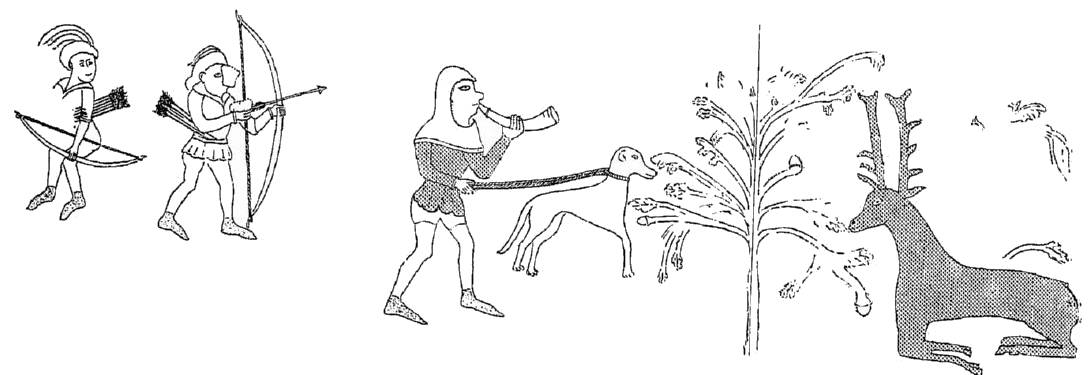Drawing of the remains of mural decoration in Holycross Abbey, Co. Tipperary, Ireland, late 14th-early 15th Centuries.Extract from pp.41-2, Eighty-first annual report of the Commissioners of Public Works in Ireland, with appendices. 1912-1913 APPENDIX E HOLYCROSS ABBEY, Co. TIPPERARY. Repairs. Mural Paintinqs. In the north-west angle of the north transept the remains of an outline wall painting has come to light. It is usual to describe such a drawing as "fresco" work, but that term can only be applied when the work is executed in fresh or wet plaster with oil as the vehicle. The method adopted in the wall paintings in churches is better described by the word "tempera," from which the term distemper has come into use. The drawings occupy a space of about 4 feet in height and 16 feet in length. One half of this is in the west wall of the transept, and the other half is continued through the angle to the north wall. The subject is a hunting scene, an archer with on attendant, a hound on leash and a stag surrounded by the foliage of oak trees in the branches of which acorns are depicted. The dress is of the medieval period; all the figures have doublets and hose. The doublets came into use from France in the 14th century, and were made of leather or a quilted fabric. The buskins or sollerets are long and sharp-pointed, denoting the end of the 14th century or the beginning of the 15th. They are marked with black spots to represent the hair of the untanned skins, like the shoes worn by the natives of the Aran Islands at the present time, which are untanned. The huntsman, blowing a horn and holding the hound on leash, wears a monk-like hood resting on the shoulders, which finds a parallel in the camail or mail-coif as represented in effigies of this period. The plaster is broken off where the face and left hand of the archer is represented. He is holding a bow and arrow in position; the attendant is behind him with another bow and more arrows. The drawing in outline is here reproduced to 1/24 lineal size of the original. It does not appear to represent any event connected with the history of the abbey; there is no record of any event which it would illustrate, and it is probably part of a scheme of mural decoration to cover the blank wall at this place. An idea prevailed for a time that the bare and rough-jointed masonry was left exposed, but that has now been abandoned, as all walls were plastered and frequently decorated or hung with tapestry. The Cistercian or reformed Benedictines did not at first favour ornament on the plastered walls, or stained glass windows, but the severity of the ritual was relaxed gradually about the 15th century.  Fig. 2. DRAWING OF THE REMAINS OF MURAL DECORATION IN HOLYCROSS ABBEY. |
